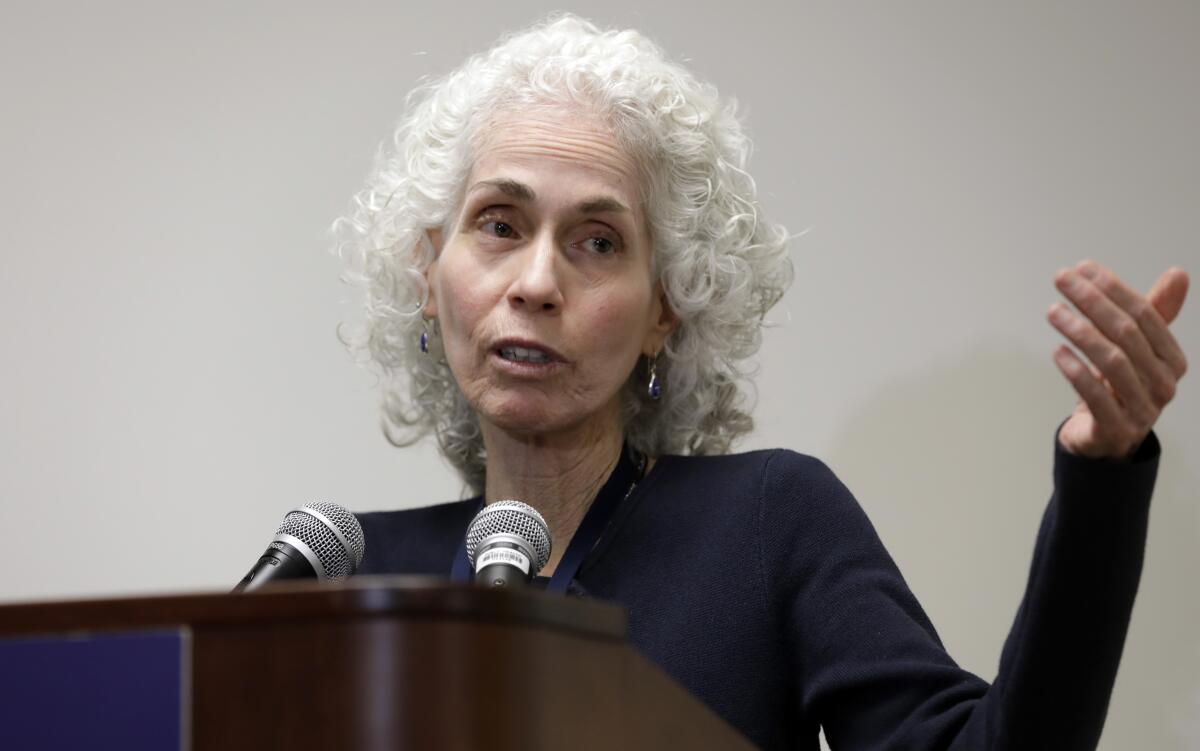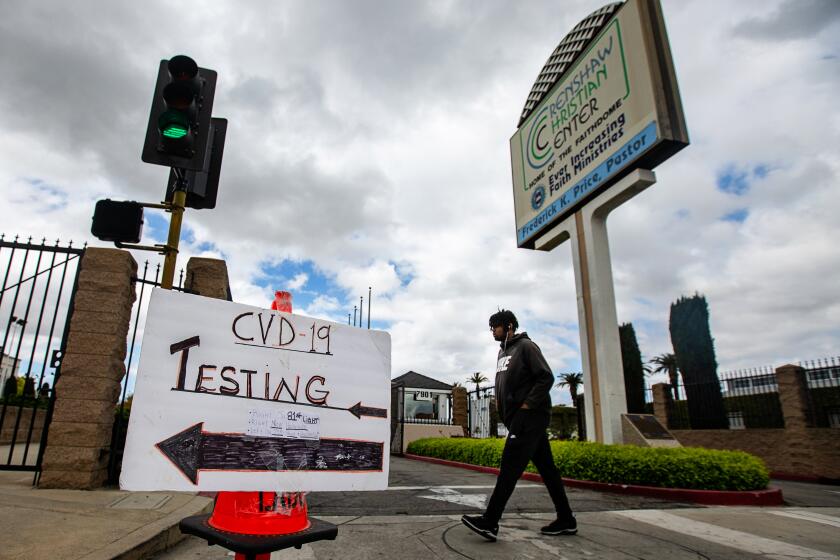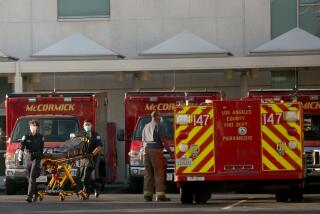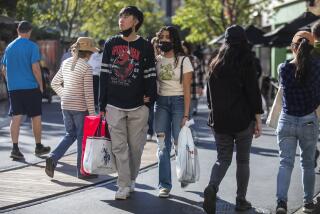Coronavirus death rate among Latinos appears low, but experts say the data are thin

Preliminary data released this week by Los Angeles County appeared to offer a glimmer of hope for the county’s largest ethnic group: Latinos, who make up nearly half the county’s population, represent just over a quarter of its coronavirus deaths.
But experts warn that the early, and incomplete, information may paint a murkier picture.
Latinos are typically younger than other demographic groups, an advantage against a virus that ravages older patients. But they also tend to live in larger households, have poor access to healthcare and work in “essential services” fields that require them to be out of the house — all factors that have some researchers predicting a coming surge in coronavirus deaths among Latinos.
The initial findings stood in contrast to the effect that the coronavirus has had on the county’s black population, which has experienced a slightly higher death rate compared with other races. Deaths among white and Asian American residents were relatively in line with those groups’ share of the county population.
On Wednesday, Barbara Ferrer, the county’s top public health official, warned against drawing conclusions based on the figures released by her department, which found that Latinos accounted for 28% of deaths from COVID-19. The data were based on 57% of the reported deaths; the county has yet to receive race and ethnic data for the remainder.
“Because it’s so preliminary, it’s probably not a good idea for us to either hold that number as … an accurate number or to really look and try to figure out what may be happening differently in the Latinx community when compared to some of the other communities,” Ferrer said.
The figures aligned with new information released Wednesday by Gov. Gavin Newsom’s administration showing that Latinos accounted for 29% of coronavirus deaths statewide, though they make up 39% of California’s population.
Coronavirus: L.A. releases first racial breakdown of fatalities; African Americans have higher death rate
The new findings ran counter to assumptions from public health experts who focus on the Latino community.
“The first time I read these results, I was quite surprised,” said Arturo Vargas Bustamante, professor of health policy at UCLA, adding that he expected “that Latinos would do worse compared to the white population, and really relatively close to the outcomes of African Americans.”
The prediction comes from a number of factors. Latinos are less likely to have access to healthcare and have high rates of certain underlying medical conditions that exacerbate the risk of COVID-19.
“Latinos in particular are more likely to have multiple chronic conditions like asthma and diabetes,” said Jeffrey Reynoso, executive director of the Latino Coalition for a Healthy California. “So in L.A. County, for example, Latino and other immigrant communities are at risk from air pollution along freeways resulting in increased asthma rates.”
One upside for the Latino population is its youthful skew. Roughly one-third of the population statewide is younger than 20, compared with around 20% for other demographic groups. That means a smaller percentage of the Latino population is at risk of falling severely ill with COVID-19.
More information about deaths broken down by age and gender will help flesh out our understanding of the virus’ effect on Angelenos, said Dr. Wendy Cozen, professor of preventive medicine and pathology at USC’s Keck School of Medicine.
“Right now, age is the strongest determinant of death,” Cozen said. “Our Latino population is young. There are probably more older people in the African American population. When these data become available, it will be easier to interpret.”
There are some indications that Latinos had heightened concerns about the COVID-19 pandemic relative to the broader population. A Pew Research poll last month found that about two-thirds of Latino adults considered the coronavirus outbreak a major threat to the health of the U.S. population as a whole, compared with about half of the general public.
“People who are more conscious since the beginning of the epidemic would probably be taking more precautions against the potential of being exposed to someone with the disease or washing their hands or wearing a mask,” Vargas Bustamante said.
Starting this week, Latino stars from TV shows like “Vida,” “Gentefied” and “One Day at a Time” will live stream readings of student scripts.
That alertness has been amplified in the news media geared toward Latinos, said David Hayes-Bautista, director of the Center for the Study of Latino Health and Culture at UCLA’s School of Medicine. He said just this week he has done two interviews with Univision about the coronavirus.
“Clearly in the Spanish-language media, both print and electronic, there’s just been a high, high awareness,” he said.
COVID-19 precautions are a deadly serious matter for 70-year-old Pasadena resident Sam Covarrubias.
The retiree, who manned the front line for various healthcare battles over a 45-year career as a registered nurse, falls into the category most vulnerable for COVID-19 contraction.
“If I get it, I know I’m screwed,” Covarrubias said. “I have heart and lung problems and I’ve had heart surgery. Plus, I’m 70 and that puts me in the group most susceptible, so I’m taking this extremely seriously.”
Over the last 2½ weeks, Covarrubias eliminated trips to local supermarkets, opting for online services such as Amazon and Instacart. He’s also had concerned family members routinely check in to see if he needs anything.
“I use gloves, masks, hand sanitizers and I wash my hands frequently,” he said. “I’m not taking any chances.”
Covarrubias was astonished to hear the coronavirus-linked death rate for Latinos was relatively low. From his experience, he assumed the opposite.
“To be honest, when I go outside I would say 80% of Latinos aren’t taking many, if any, precautions,” he said. “Plus, we’re kind of skeptical about things we hear and kind of go our own way.”
Jessica Rodriguez, a 36-year-old e-commerce manager, was similarly stunned by the county’s findings.
“It actually surprised me to hear that because I feel like in a lot our communities we all live with our tíos and tías,” said Rodriguez, referring to uncles and aunts. “I was concerned that would have an impact on us and the chances for increased exposure.”
Rodriguez, a Highland Park native, somewhat fits that billing as she lives in a two-bedroom, two-bathroom Montebello apartment with her husband, two children and 73-year-old father-in-law.
‘It actually surprised me to hear that because I feel like in a lot our communities we all live with our tíos and tías. I was concerned that would have an impact on us and the chances for increased exposure.’
— Jessica Rodriguez, of Highland Park
Hayes-Bautista said those living patterns, in which Latino households typically tend to have at least one more person than other groups, could be a cause for future concern.
Another is the fact that many Latinos work in jobs that are still deemed essential — including service jobs in grocery stores and pharmacies, healthcare and janitorial work, and farm labor picking crops — and may feel financial pressure to work, upping the risk of exposure.
Add in their lower rates of health insurance and shortage of Latino doctors, and Hayes-Bautista predicted the low Latino death rate may not stay that way for much longer.
Scott Blanks, 34, of Whittier, had outgrown childhood asthma but couldn’t overcome COVID-19.
“I call it almost a perfect storm,” Hayes-Bautista said.
But Rodriguez said there is one big advantage Latinos have in their battle against COVID-19: a strong sense of community.
She sees friends, neighbors and family members purchasing groceries for each other to cut down on exposure, children helping parents and elders with chores and work, and frequent discussions about COVID-19.
“We’re always communicating,” Rodriguez said. “We’re always looking to help each other. We believe in community. That’s what we do best.”
More to Read
Start your day right
Sign up for Essential California for news, features and recommendations from the L.A. Times and beyond in your inbox six days a week.
You may occasionally receive promotional content from the Los Angeles Times.









